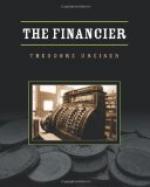“There, my son,” said his father to him one day, “you won’t often see a bundle of those around this neighborhood.” He referred to a series of shares in the British East India Company, deposited as collateral at two-thirds of their face value for a loan of one hundred thousand dollars. A Philadelphia magnate had hypothecated them for the use of the ready cash. Young Cowperwood looked at them curiously. “They don’t look like much, do they?” he commented.
“They are worth just four times their face value,” said his father, archly.
Frank reexamined them. “The British East India Company,” he read. “Ten pounds—that’s pretty near fifty dollars.”
“Forty-eight, thirty-five,” commented his father, dryly. “Well, if we had a bundle of those we wouldn’t need to work very hard. You’ll notice there are scarcely any pin-marks on them. They aren’t sent around very much. I don’t suppose these have ever been used as collateral before.”
Young Cowperwood gave them back after a time, but not without a keen sense of the vast ramifications of finance. What was the East India Company? What did it do? His father told him.
At home also he listened to considerable talk of financial investment and adventure. He heard, for one thing, of a curious character by the name of Steemberger, a great beef speculator from Virginia, who was attracted to Philadelphia in those days by the hope of large and easy credits. Steemberger, so his father said, was close to Nicholas Biddle, Lardner, and others of the United States Bank, or at least friendly with them, and seemed to be able to obtain from that organization nearly all that he asked for. His operations in the purchase of cattle in Virginia, Ohio, and other States were vast, amounting, in fact, to an entire monopoly of the business of supplying beef to Eastern cities. He was a big man, enormous, with a face, his father said, something like that of a pig; and he wore a high beaver hat and a long frock-coat which hung loosely about his big chest and stomach. He had managed to force the price of beef up to thirty cents a pound, causing all the retailers and consumers to rebel, and this was what made him so conspicuous. He used to come to the brokerage end of the elder Cowperwood’s bank, with as much as one hundred thousand or two hundred thousand dollars, in twelve months—post-notes of the United States Bank in denominations of one thousand, five thousand, and ten thousand dollars. These he would cash at from ten to twelve per cent. under their face value, having previously given the United States Bank his own note at four months for the entire amount. He would take his pay from the Third National brokerage counter in packages of Virginia, Ohio, and western Pennsylvania bank-notes at par, because he made his disbursements principally in those States. The Third National would in the first place realize a profit of from four to five per cent. on the original transaction; and as it took the Western bank-notes at a discount, it also made a profit on those.




